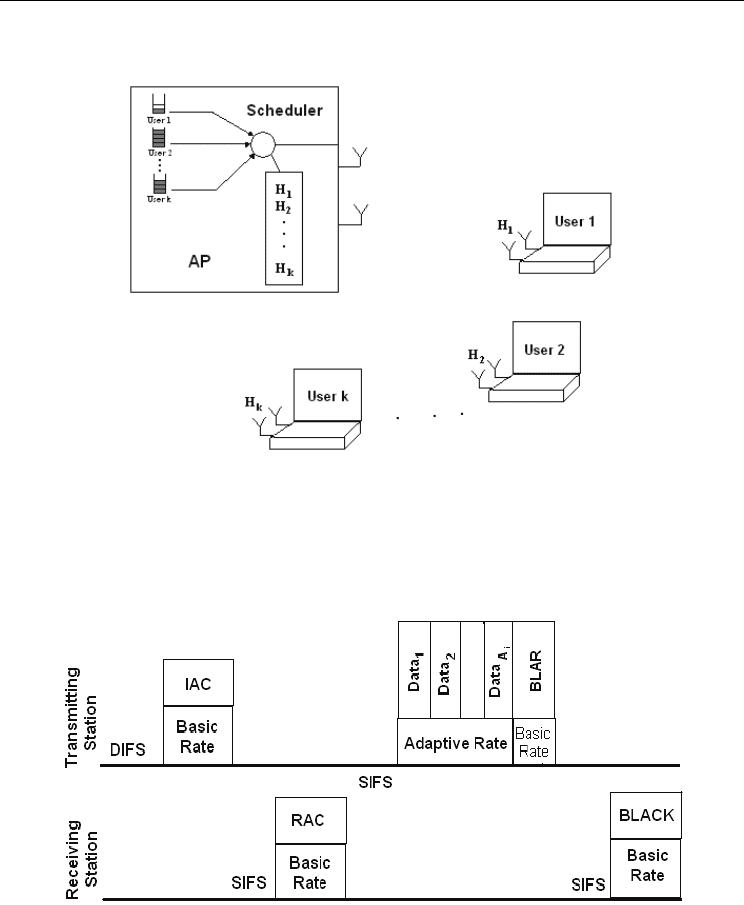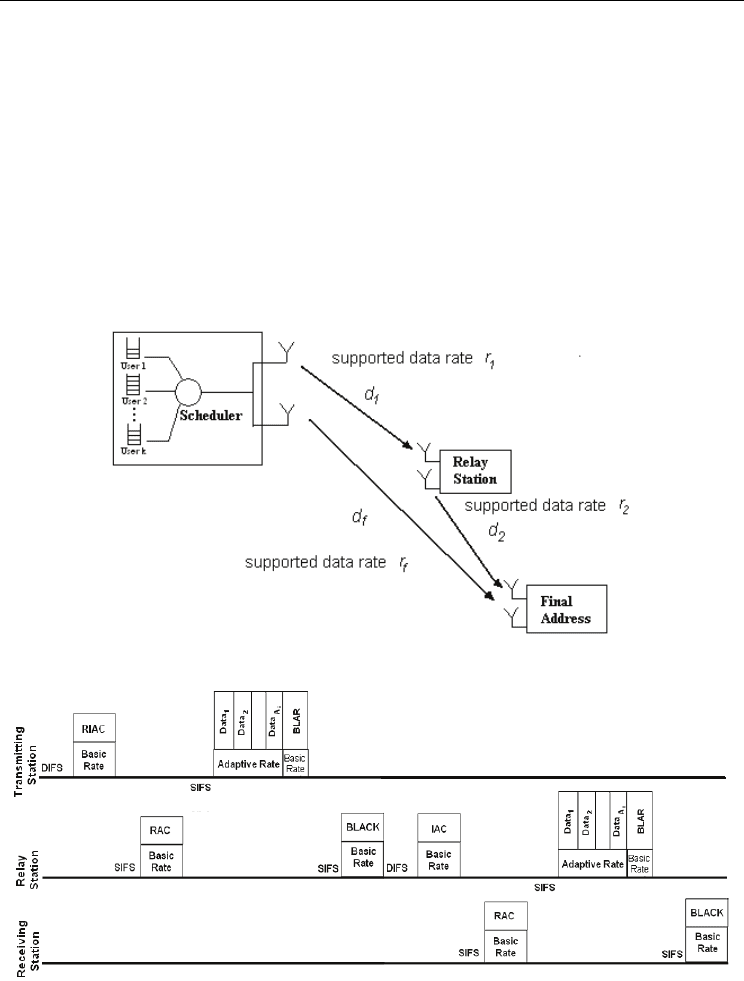Bednorz W. (ed.) Advances in Greedy Algorithms
Подождите немного. Документ загружается.


Opportunistic Scheduling for Next Generation Wireless Local Area Networks
391
For medium access, we consider a time division system where only one user is served at a
given time period, limited by a duration called transmission opportunity (TXOP).
Fig. 1. A typical 802.11n AP and terminals
As defined by 802.11n draft standard, within a TXOP, a two-way handshake with frame
aggregation can be performed as shown in Figure 2 [Mujtaba, 2004]. Initiator Aggregation
Control (IAC) and Responder Aggregation Control (RAC) are RTS/CTS-like reservation
messages, which also involve training sequences to help (MIMO) channel estimation and
data rate selection.
Fig. 2. Example aggregate frame transmission
After IAC/RAC exchange, a number of data packets are aggregated in one frame and an
acknowledgement is requested in the end via the Block ACK Request (BLAR) packet. The
destination station replies with a Block ACK (BLACK) packet that contains the reception
status of packets in the aggregation. The data packets are transmitted at the selected
transmission rate, while the control packets (IAC, RAC, BLAR and BLACK) are transmitted
at the basic rate, so that all stations can decode these packets. The inter frame spacing (DIFS,

Advances in Greedy Algorithms
392
SIFS) values are as in the 802.11 specification. At each TXOP, the AP transmits to a station
selected according to the implemented scheduling algorithm.
4. Proposed scheduling algorithms for next generation WLANs
4.1 Aggregate opportunistic scheduling
Despite the performance enhancing techniques introduced by IEEE 802.11n, namely MIMO
and frame aggregation, the throughput observed by the system depends on the channel and
queue states of the selected user, hence scheduling. Our motivation here is that throughput
can essentially shape scheduling, and we propose Aggregate Opportunistic Scheduling (AOS)
algorithm [Ciftcioglu & Gurbuz, 2006], where the scheduler tries to maximize the
instantaneous throughput when the AP is transmitting a number of packets in aggregation
to a selected user. In other words, for i
th
TXOP, the AOS scheduler selects a user k
i
* as
*
arg max
k
ii
k
kS=
, (6)
where
k
i
S
is the throughput calculated for i
th
TXOP and k
th
user with the actual system
overhead and parameters, as shown next. Considering traffic destined to the k
th
station in
the i
th
TXOP, the point-to-point downlink throughput,
k
i
S
, can be calculated as
00 0 0
)
.
.(
4. 4. 3.
k
i
P
IAC RAC BLACK
BLAR P MH
PLCP
k
i
k
i
k
i
LL L
L
AL L
TDIFS SIFS
rr r r
C
S
A
L
τ
=
+
⋅
++ + ++ + + +
(7)
with A
k
i
being the instantaneous aggregate size to user k at i
th
TXOP and L
P
, L
IAC
, L
RAC
,
L
BLACK
, L
BLAR
are the length of the data, reservation, ACK and ACK request packets,
respectively. L
MH
is the MAC header in bits, T
PLCP
is duration of physical layer training
header,
τ
is the one way propagation delay and DIFS, SIFS are inter frame spacing times
specified in 802.11 [Mujtaba, 2004]. Finally, r
0
is the basic data rate at which control packets
are transmitted and
k
i
C
is the instantaneous capacity, i.e., maximum achievable data rate to
communicate with user k, which depends on the channel state. Instantaneous aggregate size
is determined as the minimum of the user’s queue size and the maximum allowable
aggregation size, which is set according to limit of transmission opportunity duration. Here,
only the downlink traffic is considered, hence there are no collisions and losses are merely
due to protocol, packet and physical layer overhead.
Another version of AOS, Aggregate Discrete Opportunistic Scheduling (ADOS) is also
developed with slight modifications. In ADOS, again the throughput maximizing user is
selected, but the throughput values are calculated by substituting one of the specified
transmission rates of 802.11n,
k
i
r
for capacity,
k
i
C
in throughput calculation in (7).
k
i
r
is
selected from the set,
d
R
={12,24,36,48,72,96,108,144,192,216} Mbps through a rate matching
mechanism, as defined in [Mujtaba, 2004].
4.2 Scheduling with relaying
In this section, we try to take advantage of relaying in our schedulers through increased
data rates due to reduced path loss. Relaying offers improvements in throughput and range

Opportunistic Scheduling for Next Generation Wireless Local Area Networks
393
extension in wireless networks, making use of multihop communication [Boyer et al.,2004],
[Sreng et al., 2002]. Using intermediate relaying stations enables the communication to be
carried out through shorter distances where the path loss much is lower as compared to
direct transmission. The reduced path loss results in range extension or improved reliability
over the same range, which enables transmitters to use lower transmission powers or using
higher data rates.
Our aim is to exploit relaying when it offers throughput enhancement with the information
available at the AP. For simplicity, we consider only one relaying station. Figure 3 below
shows the relaying scenario, where the end station is located at d
f
meters from the AP
operating at data rate r
f
, and the relay station is located at d
1
(operating at data rate, r
1
). The
distance between the relay and end stations is d
2
, and the data rate of the corresponding link
is r
2
. Figure 4 depicts our modifcitions to 802.11n transmission sequence so as to allow frame
aggregation in relaying mode.
Fig. 3. Relaying with one relay station.
Fig. 4. Frame aggregation with one relay station in IEEE 802.11n.
In order to implement relaying over the 802.11n protocol, the first IAC packet is modified as
Relayed IAC (RIAC) by adding fields to the packet which indicate whether relaying is

Advances in Greedy Algorithms
394
required or not and the adddress of the relaying station. The relay station initiates another
contention-free transmission sequence to the destination. A new transmission sequence will
not be initiated at the AP unless the Block ACK is received from the end station. The
principle of relaying structure can also be applied to wireless mesh networks [Bicket et al.,
2005] ,[Navda et al., 2005] using the IEEE 802.11n interface.
In order to determine whether relaying is beneficial for transmitting data to an end user or
not, we compare the transmission durations. Without relaying, the total transmission
duration to the end station is given by:
00 0 0
.
4. 4. 3.
IAC RAC BLACK
B
LAR P
PLCP
f
r
L
LL
L
A
L
TTDIFSSIFS
direct
rr r r
τ
= ++ + ++ + + +
(8)
.
P
f
r
A
L
T
overhead
=+
(9)
When relaying is employed, the resulting transmission duration is found as:
12
..
2.
PP
rr
A
LAL
TT
relay overhead
=++
(10)
Clearly, relaying is beneficial if relaying offers a shorter transmission duration than direct
transmission, i.e., when T
relay
< T
direct
. An alternative approach to determine whether relaying
is beneficial is to define an equivalent relaying rate. For this, we decompose equation (10) as
follows:
12
..
PP
rr
A
LAL
TT T
relay overhead overhead
=+++
, (11)
12
.
.
11
P
P
T
overhead
TALT
relay overhead
rr AL
⎛⎞
=++ +
⎜⎟
⎜⎟
⎝⎠
. (12)
Note that the form of (12) is similar to (9) with the total duration as the sum of overhead
delay and a rate-dependent term multiplied by the aggregated frame size, in bits. We define
the equivalent relaying rate as
1
12
.
11
equivalent
iP
T
overhead
r
rr AL
−
⎛⎞
=++
⎜⎟
⎜⎟
⎝⎠
, (13)
and rewrite (12) as
.
P
equivalent
r
A
L
TT
relay overhead
=+
(14)
r
equivalent
not only consists of rate-dependent terms, but it also depends on the aggregate size,
A which in turn depends on the queue state for the final station. Hence, increasing aggregate
size increases the equivalent relaying rate.

Opportunistic Scheduling for Next Generation Wireless Local Area Networks
395
Considering relaying, the queue aware schedulers have been modified as follows: For each
destination station, the effective relaying rate, r
equivalent
is calculated using (13) considering
each possible intermediate station as a relay station. Then, the best relaying station is
selected as the station which enables the maximum effective relaying rate to the destination
station. Next, the selected maximum effective relaying rate is compared to the direct rate. If
relaying rate is larger than direct transmission rate, relaying is to be preferred, hence the
corresponding metric, η
k
of the scheduler (AOS, CQS, LQ etc.) is computed for user k using
effective relaying rate. If the relaying rate is smaller than direct rate, the metric η
k
is
computed according to direct transmission. In the end, user scheduling is performed by
selecting the user that maximizes the selection metric according to,
*
arg max
k
k
k
η
=
.
Typically, relaying will improve the rates of stations with poor channel conditions which are
located far away from the AP, equivalently increasing their metrics, increasing their chances
for being served by the AP. As a result, we expect relaying to improve the fairness
peformance of the schedulers. In addition, since higher effective data rates are used,
relaying should improve throughput of the non-opportunistic scheduler LQ. For
opportunistic schedulers, both effective data rates and the proportion of service for users
with poor channels are expected to increase.
4.3 Predictive scheduling with time waterfilling
Selecting the user that maximizes the instantaneous throughput at a specific transmission
opportunity may lower the throughput in the subsequent transmission opportunities.
Likewise, increasing the participation of low capacity users can later enable the higher
capacity users to transmit with larger aggregate sizes and hence result in higher efficiency
and throughput. Our aim in this section is to design block scheduling algorithms that
perform allocation of multiple users, so as to maximize the overall throughput over a long
term, the duration of which is set as an external parameter. Hence, we propose an algorithm
where the access privileges and proportions of users are determined based on predicted per
user aggregate size and throughput values. A queuing model is first developed for
analyzing packet queueing after transmissions with frame aggregation in 802.11n downlink
channel and then the outcomes of the queuing model are used to calculate long term
average aggregate size and average throughput, which are then utilized in designing the
heuristics of Predictive Scheduling with Time Water-filling (P-WF).
4.3.1 Queuing formulation
Here, we devise a queuing model for aggregate frame transmissions of the 802.11n MAC
by extending the bulk service model in [Kleinrock, 1975]. From this queuing model, we
compute the state probabilities, where each state corresponds to the number of packets
included in the bulk that is an aggregate frame. By using the obtained state probabilities,
we compute the expected aggregate size and throughput per user, and then the long term
overall system throughput and accordingly design the metrics of the block schedulers.
Figure 5 shows the bulk service model, where the packets are served collectively in
groups and incoming packets are enqueued. Packets arrive one by one with an average
rate,
λ
packets/second. All of the packets in the queue are served together if the number
of packets is less than the bulk size, L. If the queue length exceeds L, only the first L
packets are served.

Advances in Greedy Algorithms
396
Fig. 5. Bulk service system
The bulk service rate,
μ
, is defined as the rate of serving bulks, which is assumed constant
for all states [Kleinrock, 1975].
The assumption of constant bulk service rate implies that the processing rate in bits per
second is to be increased proportionally with the bulk size. For transmissions over a wireless
link, the channel data rate can vary due to variations in channel conditions, but in a given
rate setting data transmission rate does not change with bulk size. Moreover, in realistic
aggregate frame transmissions MAC and physical layer overhead should also be taken into
account in determining the service rates. Therefore, for our queing model of aggregate
transmission, the service rate μ
j
is variable and is obtained as:
.
1,
.( ) .
.
,
.( ) .
P
P MH overhead IFS
j
P
P MH overhead IFS
jL
j
L
jjLL L rT
LL
jL
LLL L L rT
μ
μ
μ
⎧
⎛⎞
⋅≤<
⎪
⎜⎟
++ +
⎪
⎝⎠
=
⎨
⎛⎞
⎪
⋅≥
⎜⎟
⎪
++ +
⎝⎠
⎩
bulks/sec (15)
where j is the number of packets involved in the aggregation; μ is the rate of serving bulks;
L
overhead
accounts for the total overhead including PHY ad MAC headers; T
IFS
is the sum of
interframe durations; r is the channel data rate determined according to the channel
conditions which vary over time due to fading.
Assuming Poisson packet arrivals, i.e., exponential inter arrival times, helps us to model the
queuing system in terms of a Markov chain, due to the memoryless property of exponential
distribution [Kleinrock, 1975]. Although Poisson distribution may exactly model the data
traffic applications, it provides an adequate reference for comparing the evolution of
different user queues in the AP, hence a relative performance can be obtained for scheduling
purposes. Similar assumptions have been made in previous work on modeling WLAN
traffic [Bianchi, 2000] as well as scheduler design [Zafer & Modiano, 2005]. Figure 6 depicts
the Markov chain representation of the queueing model of aggregate frame transmissions,
defining the state as the number of packets in the queue. Packets arrive at average rate
λ
,
and bulks are served at rate μ
j
, given by Eq.(15).
Using this model, we derive the state probabilities, p
1
, p
2
,...,p
L
, at steady state by solving the
balance equations:
01122 0
1
... (1 )
L
LL j j
j
ppp pp p
λμμ μ λμ
=
=+ ++ ⇒=
∑
(16a)

Opportunistic Scheduling for Next Generation Wireless Local Area Networks
397
1
() 1
jj LjL j
p
pp jL
λμ μ λ
+−
+
=+ ≤≤
(16b)
1
()
Lj LjL j
p
pp jL
λμ μ λ
+−
+
=+ ≥
(16c)
Converting the balance equations into the alternative form by taking the z-transform, we
obtain P(z) in rational form as follows:
1
1
[( )( ) ]
()
()
L
Lj Lj
Lj L j
jL j L j
j
LL
LL
zz zp
Pz
zz
μμ μμ
μμ μ μ
λλ
λλμμ
+
=
+
−− + + +
=
−+ +
∑
i.e., (17)
)(
)(
)(
zD
zN
zP =
(18)
Fig. 6. Markov-chain representation of aggregate frame transmission
The global sum of probabilities should be equal to 1, requiring P(1)=1 to be satisfied. Since
both N(1)=0 and D(1)=0, we need to utilize the L’Hospital rule and solve
1
'( )
lim 1
'( )
z
Nz
Dz
→
= . The
next step is to obtain state probabilities by taking the inverse transform of P(z). The fact that
the bulk service rates are state-dependent has caused the order of N(z) to be greater than the
order of D(z), so P(z) cannot be simplified. We take an alternative approach as follows:
Similar to the bulk service model solution in [Kleinrock, 1975], out of the (L+1) roots of D(z),
(L-1) roots are located within the unit circle. Due to the fact that the z-transform of a
probability distribution is analytical inside the unit circle, P(z) should be bounded, which
implies that (L-1) zeros of P(z) must also be the roots of the numerator N(z). N(z) must also
vanish at each of the (L-1) roots of D(z) inside the unit circle. This constraint results in a set
of (L-1) equations. Including the equation provided by the L’Hospital rule, we obtain L
equations for probabilities p
1
, p
2
, ..., p
L
, and Eq. (16) provides the solution for p
0
. The set of
equations is solved via numerical computations, obtaining the steady-state probabilities of
the system for all the states up to the aggregation limit L. The expected aggregate size,
A
,
and expected throughput,
S , are found as the ensemble average, via
10
..(1 )
LL
jj
jj
A
jp L p
==
=+−
∑
∑
, (19)
00
( ) (1 )()
LL
jj j
jj
SpSA pSL
==
=+−
∑∑
, (20)

Advances in Greedy Algorithms
398
where S(A
j
) is the throughput achieved with aggregate size A
j
.
The queuing model provides us the expected aggregate size and expected throughput for a single
queue (user) given the service rate and applied load. Considering the multi user scenario
with time-division multiplexed traffic, the parameters for the queuing model need to be
modified by taking the temporal access proportions into account. Given the temporal access
proportion of a user as π
n
, where π
n
∈
[0,1], the effective channel service rate of that user is
to be computed by scaling its link rate by π
n
. From Eq. (17), it can be verified that, scaling the
service rate by π
n
with a given load level has the same effect as keeping service rate and
scaling the load level by a factor of 1/π
n
. Hence, the effective load at the nth user queue is
obtained as λ
n
/π
n
, and the bulk service rate μ
j
is found from Eq. (15) as a function of the data
rate of the served user’s wireless channel (r
n
) and the aggregate size j
n
. After computing the
state probabilities, the expected throughput per user n,
n
S
, is obtained as:
,()
()
(), ()
nn
nn
nn
n
n
SL
Sf
SL SL
λλ
ππ
π
λ
π
⎧
<
⎪
⎪
==
⎨
⎪
>
⎪
⎩
, (21)
where S(L) is the maximum throughput that can be achieved with the maximum allowed
aggregate size, L. The overall network throughput is obtained as the weighted average of
the per user throughput values:
1
N
total n n
n
SS
π
=
=
∑
, (22)
with N being the total number of users to be scheduled.
The calculation of the state probabilities and estimation of queue size and throughput are to
be implemented the AP. The AP has the per user information of traffic load, channel
(service) rates and queue states available. Channel states are assumed to be stationary
within a scheduling duration, as fading is assumed to be slow due to low mobility in indoor
WLANs.
4.3.2 Algorithm description
In order to maximize the total throughput, S
total
obtained in (22) we propose Predictive
Scheduling with Time-domain Water-filling (P-WF) [Ciftcioglu & Gurbuz, 2007] as a block
scheduling solution that optimizes temporal access proportions, π
n
for a given number of
users, N. The scheduling problem is described as:
1
arg max
n
N
nn
n
S
π
π
=
∑
such that
1
1
N
n
n
π
=
=
∑
. (23)
The above problem resembles the power allocation problem among users or multiple
transmit antennas for maximizing capacity of multi user or multi antenna fading channels,
solved by water-filling. In a water filling problem in general, the aim is to maximize the
weighted average of a quantity in the form:

Opportunistic Scheduling for Next Generation Wireless Local Area Networks
399
1
max ( )
N
nn
n
x
βγ
=
+
∑
with the constraint
1
1
N
n
n
x
=
=
∑
. (24)
The solution for (x
1
,x
2
, ... x
N
) is given as [Cover & Thomas, 1991]:
( ) , 1,...,
opt
n
n
x
nN
β
ζ
γ
+
=− =
, (25)
where (θ)
+
denotes max(θ,0). For the power allocation problem, the solution, x
n
opt
is the
optimal transmission power level for each channel n with SNR value γ
n
and the power cut-
off value, ζ is a function of receiver’s acceptable threshold SNR. We exploit the mathematical
analogy between equations (23) and (24), where power level is analogous to temporal access
proportion. Then, we apply the concept of waterfilling for determining the time proportions
π
n
that maximize S
total
and we name this method as time-domain waterfilling. In order to
achieve a full analogy between the equation pairs, we add a constant into the summation
term on the left in Eq. (23) and obtain:
1
'( )
N
n
n
n
SS
βπ
=
=+
∑
. (26)
Maximizing S’ is equivalent to maximizing S
total
, so the waterfilling solution is found as:
n
n
S
β
πς
+
⎛⎞
=−
⎜⎟
⎝⎠
, n=1, ..., N (27)
Unlike traditional waterfilling, the solution cannot be computed directly due to the coupling
between the waterfilling terms,
n
S
and π
n
. At this point, we propose the following heuristic
algorithm to find best π
n
values:
1. Initialize all temporal proportions equally, as
0
n
π
=1/N for n=1...N.
2. For iteration i,
• Compute the effective load values,
0
i
n
n
i
n
λ
λ
π
= , for each user,
n
∀
.
• Calculate the per user average aggeragate size,
()
ii
n
A
λ
and per user throughput,
()
ii
n
S
λ
from the analytical model.
• Find access proportions from water filling solution as
1
()
i
n
ii
n
S
β
πς
λ
+
+
=−
⎛⎞
⎜⎟
⎝⎠
also
solving for cut off value, ζ using
0
1
()
N
ii
i
n
S
β
ς
λ
=
+
−
=
⎛⎞
⎜⎟
⎝⎠
∑
. Initially, all of the access
proportions are assumed to be greater than zero, and cut off is obtained as:
0
11
()
N
ii
i
n
NN S
β
ς
λ
=
⎛⎞
=+
⎜⎟
⎝⎠
∑
. If
()
ii
n
S
β
ς
λ
>
is satisfied for all users, the iteration is
completed. Otherwise, cutoff is calculated by eliminating users with low
throughput, until the number of users surpassing ζ is consistent with the number of
terms in the summation.

Advances in Greedy Algorithms
400
Step 2 with its sub steps is repeated until, after a finite number of iterations, the access
proportions (π
n
s) converge. The resulting proportions indicate optimal transmission
durations of the users relative to the total transmission sequence in which scheduling is
applied. Users below the threshold ratio are not served, similar to waterfilling schemes for
power allocation, where poor channels are not allowed to transmit when their Signal to
Noise Ratio (SNR) fall below the cutoff value.
Having determined the temporal access proportions, next, we need to determine the
sequence of transmissions for the selected active users. For this purpose we use an approach
that is similar to calculation of finish tags in fluid fair queuing [Leon Garcia & Widjaja,
2004]. Each active user is assigned a turn number, which indicates the number of times the
user will be given access throughout the total scheduling duration. The turn number, t
n
for
user n is determined in two steps: First, the ratio of the access proportion of the user to the
transmission duration of serving that user is calculated, then all calculated turn numbers are
scaled with respect to the minimum turn number. In other words,
**
nn
n
n
n P n overhead
t = =
T
(( A .L )/ r + T )
ππ
,
(28)
*
*
**
12
0
12
' min , ,..., ,
Active
n
Active
N
N
t
TT T
π
π
ππ
>
⎛⎞
=
⎜⎟
⎜⎟
⎝⎠
12
12
, ,...,
'' '
A
ctive
Active
N
N
t
tt
tt t
tt t
== =
(29)
where T
n
is the transmission duration of serving user n,
n
A
is the average aggeragate size
calculated from the queuing model for user n, T
overhead
refers to the sum of all the overhead
terms in Eq. (7). The optimal solution can yield some of the users with a zero access
proportion, so N
active
is the total number of users with a non-zero access proportion. The
transmissions of those active users are scheduled in ascending order of their turn numbers.
This ordering makes sure that the users with the smaller access proportions get their
allocation before the others.
5. Performance evaluation
5.1 Performance of scheduling algorithms
In this section, the performance of proposed Aggregate Opportunistic Scheduling (AOS and
ADOS) and Predictive Block Scheduling with Time-Waterfilling (P-WF) schemes are evaluated
in comparison to the scheduling disciplines from the literature namely LQ [Mujtaba, 2004],
MRS [Knopp & Humblet, 1995], PFQ [Jalali et al., 2000], CQS [Neely et al., 2002], SRPT
[Schrage & Miller, 1966] and OAR
2
[Sadeghi et al., 2002]. The simulations are carried out in
the OPNET simulation environment, modeling the wireless channel, physical layer
parameters, 802.11 MAC layer with 802.11n enhancements and the scheduling algorithms.
For the wireless channel, the log-normal path loss model is simulated with path loss
exponent of 2 and log-normal shadowing deviation of 3 dB within a distance of 5 meters
2
The OAR algorithm defines the aggregate size as the ratio of the data rate of the station
over basic rate. Here, we have considered two versions of OAR, where the algorithm is
applied with a basic rate of 12 Mbps (OAR-12) and with a basic rate of 24 Mbps (OAR-24).
